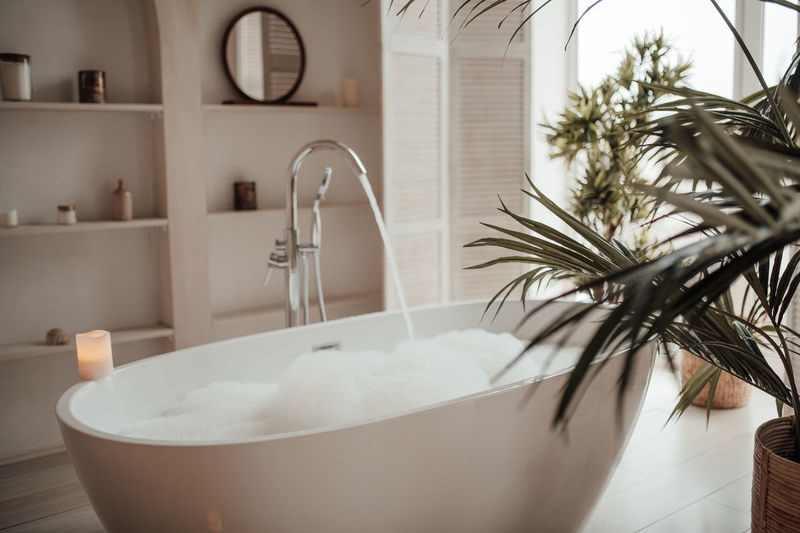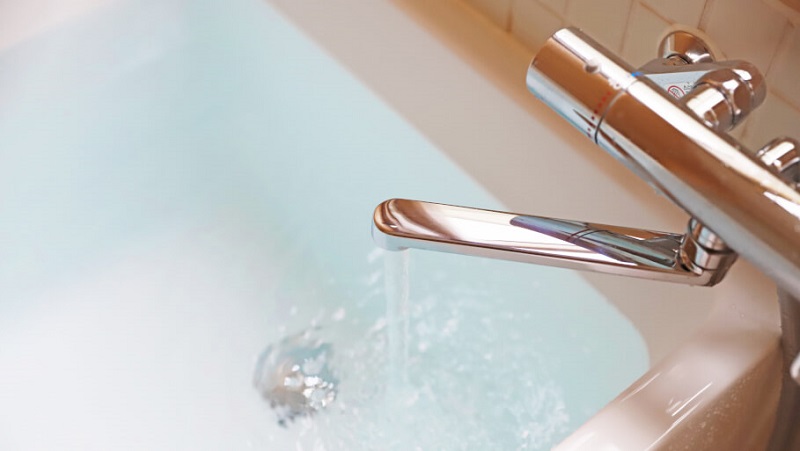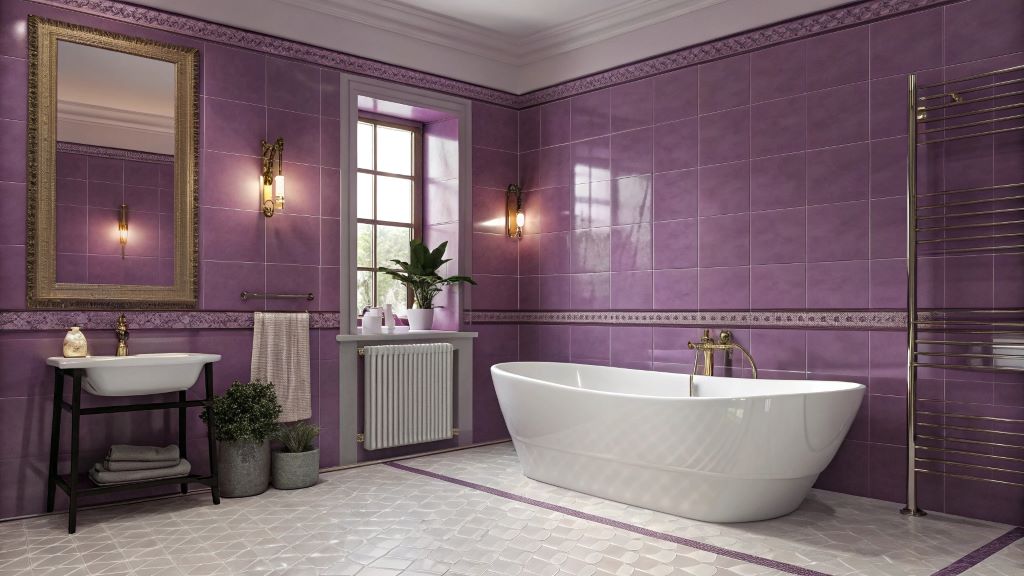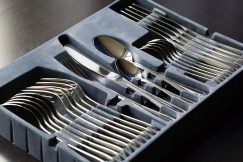Picture this: You step into your bathtub, ready for a relaxing soak, only to find yourself ankle-deep in water that just won’t drain away. The annoyance of a pooling bathtub can quickly turn your tranquil moment into a frustrating ordeal. But fear not, for in this article, we’ll delve into the world of bathtub water pooling and provide effective solutions to end this pesky problem. We’ll explore the various causes of water pooling, the DIY remedies you can try when it’s time to call in the experts, and even some creative DIY solutions for temporary issues. Let’s dive in!
Importance of Addressing the Issue
Before diving into the solutions, let’s understand why addressing a pooling water issue in your bathtub is crucial. Beyond the obvious inconvenience, water pooling can lead to many problems. Stagnant water can create a breeding ground for mold and mildew, posing health risks and damaging your bathroom’s aesthetics. Additionally, water pooling can weaken the structural integrity of your bathtub and its surroundings, leading to costly repairs in the long run.
Understanding the Causes of Bathtub Water Pooling
Grime and Soap Scum Buildup
One common culprit behind water pooling is the grime and soap scum buildup in your drain. Over time, these substances can clog the drain, preventing water from flowing freely.
Damaged or Improperly Sealed Drain
A damaged or improperly sealed drain can result in leaks and poor drainage. If water escapes through gaps or cracks around the drain, it can accumulate in the bathtub.
Clogged or Slow-Draining Pipes
Clogged or slow-draining pipes can hinder water flow, causing it to back up and pool in the tub. Hair, soap residue, and other debris are often the culprits.
Incorrect Bathtub Slope or Design
The design of your bathtub plays a significant role in proper drainage. If the slope of your bathtub is not conducive to efficient drainage, water pooling can occur.
The DIY Approach: Steps to Prevent Water Pooling
Inspecting and Cleaning the Drain
Start by removing any visible hair and debris from the drain. A drain snake or plunger can help dislodge stubborn clogs. If you prefer natural solutions, try pouring a mixture of baking soda and vinegar down the drain, followed by hot water.
Addressing Grime and Soap Scum Buildup
Choose effective cleaning products specifically designed to break down grime and soap scum. Establish a regular cleaning routine to prevent buildup. For eco-conscious individuals, DIY natural cleaners like lemon and baking soda can work wonders.
Ensuring Proper Bathtub Slope and Design
Understand the right slope for proper drainage in your bathtub. If your bathtub lacks the ideal slope, consider adjusting or remodeling it accordingly. Placing slip-resistant mats strategically can also help water flow toward the drain.
Fixing Damaged or Improperly Sealed Drains
Look for signs of a damaged drain, such as leaks or rust. Replace faulty drain components and apply sealant to ensure proper sealing. This will prevent water from escaping and pooling underneath the tub.
Dealing with Clogged or Slow-Draining Pipes
Recognize the signs of clogged pipes, such as water taking longer to drain. Use DIY methods like a mixture of baking soda and hot water or a combination of vinegar and hot water. If the issue persists, it’s time to seek professional plumbing help.
Professional Help: When to Call in the Experts
Identifying Complex Issues
Some bathtub drainage issues may be more complex than they appear. If you’ve tried DIY remedies without success, it’s best to consult a professional plumber who can identify and address the root cause.
Benefits of Professional Assessment
Professional plumbers have the expertise and tools to diagnose and solve intricate drainage problems effectively. Their assessment can help you avoid unnecessary expenses and ensure long-lasting solutions.
Avoiding DIY Mishaps
While DIY solutions can be effective for minor issues, attempting complex repairs without the necessary skills can lead to further damage. Calling in experts is a wise choice to prevent costly mistakes.
Upgrading Your Bathtub Drainage System
Modern Bathtub Designs for Better Drainage
Consider upgrading to a modern bathtub design that prioritizes efficient drainage. These designs often feature improved slopes and innovative drainage systems.
Choosing Efficient and Stylish Drain Covers
Invest in drain covers that not only prevent clogs but also add a touch of style to your bathroom. These covers can effectively keep debris out of the drain, reducing the risk of water pooling.
Upgrading to a Pop-Up Drain
Pop-up drains offer a convenient way to control water drainage. With a simple press, you can open or close the drain, allowing you to regulate water flow and prevent pooling.
Preventing Future Water Pooling Issues
Regular Maintenance Habits
Keep your bathtub’s drain clear by routinely removing hair and debris. After each use, wipe down the bathtub to prevent soap scum buildup. However, avoid harsh chemicals that may damage your plumbing.
Educating Household Members
Teach your family members proper disposal habits to prevent clogs. Remind them to avoid letting hair and other debris go down the drain, as prevention is key to avoiding water pooling issues.
Innovative Solutions for Water Pooling
Bathtub Accessories
Invest in overflow drain covers and bathtub hair catchers to prevent debris from entering the drain. Water-absorbing sponges can also soak up excess water and reduce pooling.
Smart Bathroom Gadgets
Consider automatic drain cleaner dispensers that release cleaning agents at regular intervals, keeping your drain clear. Digital water level monitors can alert you if water levels rise unexpectedly.
The Impact of Bathtub Design on Water Pooling
Ergonomic and Anti-Pooling Designs
Modern bathtub designs often incorporate ergonomic features that promote efficient drainage. Anti-pooling designs ensure that water flows toward the drain naturally.
Modern Materials and Their Benefits
Bathtubs made from modern materials are not only durable but also resistant to water stains and scum buildup, reducing the risk of drainage issues.
Customization Options for Your Bathtub
Explore customization options that allow you to create a bathtub tailored to your preferences. Opt for a design that maximizes drainage efficiency while reflecting your style.
Addressing Common Misconceptions About Bathtub Drainage
Using Excessive Drain Cleaners
Contrary to popular belief, excessive use of drain cleaners can actually worsen drainage issues. These cleaners may damage pipes and contribute to clogs over time.
Believing All Bathtubs Drain Perfectly
Not all bathtubs are created equal. Different designs and materials can impact drainage efficiency. Regular maintenance is essential to ensure proper water flow.
Ignoring Regular Maintenance Needs
Ignoring regular maintenance can lead to gradual buildup that eventually results in water pooling. Preventive care, such as cleaning and debris removal, is essential for a well-draining bathtub.
Comparing Different Types of Bathtub Drains
Traditional Rubber Stoppers
Traditional rubber stoppers are simple and effective but may not provide the best drainage. They can lead to slow water release and potential pooling.
Trip Lever Drains
Trip lever drains offer better control over drainage. By toggling the lever, you can adjust water flow and prevent pooling.
Lift-and-Turn Drains
Lift-and-turn drains are easy to operate and can effectively prevent water pooling. Turning the stopper closes or opens the drain, allowing you to control drainage.
Push-Pull Drains
Push-pull drains are a user-friendly option for managing drainage. Push the stopper to close the drain and pull to open it, regulating water flow and preventing pooling.
When It’s Time for a Bathtub Replacement
Signs of Irreparable Damage
If you notice persistent water pooling despite trying various solutions, it may be a sign that your bathtub is irreparably damaged. Cracks, leaks, and extensive rust are indicators.
Choosing the Right Replacement Bathtub
When replacing your bathtub, opt for a design that prioritizes efficient drainage. Consult professionals for recommendations on the best bathtub for your needs.
Ensuring Proper Installation for Optimal Drainage
Proper installation is key to preventing future water pooling issues. Ensure that the new bathtub is installed with the correct slope and drainage mechanisms.
Incorporating Green Solutions for Water Drainage
Using Eco-Friendly Cleaning Products
Swap out harsh chemicals for eco-friendly cleaning products that won’t harm your plumbing or the environment. These products can help prevent clogs without causing harm.
Harvesting and Reusing Bathtub Water
Consider installing a system to capture and reuse bathtub water for tasks like flushing toilets or watering plants. This eco-conscious approach minimizes water wastage.
Installing Water-Saving Fixtures
Upgrade to water-saving fixtures like low-flow faucets and showerheads. These fixtures reduce water usage while promoting efficient drainage.
Creative DIY Solutions for Temporary Water Pooling Issues
Using Towels or Sponges Strategically
Strategically placing towels or sponges in areas prone to pooling can help absorb excess water temporarily. Remember to remove and dry them regularly.
Elevating the Drain Area Temporarily
If your bathtub slope is off, placing a small platform or improvised support under the drain area can encourage water to flow in the right direction.
Constructing a Makeshift Slope with Household Items
Create a makeshift slope using items like folded towels or small boards. Place them under the tub to tilt it slightly and facilitate water drainage.
Considering Feng Shui for Improved Bathtub Drainage

Feng Shui Principles for Bathroom Design
Incorporate Feng Shui principles into your bathroom design to enhance energy flow. Positioning the bathtub correctly can influence water drainage and overall harmony.
Positioning the Bathtub for Better Energy Flow
According to Feng Shui, positioning the bathtub in a way that aligns with energy flow can improve drainage and create a more balanced environment.
Balancing Water Elements with Other Elements
Feng Shui emphasizes balance among the five elements, including water. Balancing water elements with elements like wood and earth can positively impact drainage.
Final Thoughts
By addressing the causes of bathtub water pooling and implementing the solutions discussed in this article, you can bid farewell to the frustration of standing in a water pool during relaxing baths. Remember, maintaining a well-draining bathtub requires regular maintenance, smart upgrades, and occasional professional help. With these strategies, you can look forward to a hassle-free and enjoyable bathing experience every time you step into your bathtub.
FAQs (Frequently Asked Questions)
Q1: Can I use chemical drain cleaners to clear a clogged drain?
A1: While chemical drain cleaners can be effective, they can also damage pipes over time. Consider using natural solutions or seeking professional help for stubborn clogs.
Q2: Are pop-up drains better than traditional rubber stoppers?
A2: Yes, pop-up drains offer better control over water drainage and are less likely to lead to pooling issues.
Q3: How often should I clean my bathtub drain to prevent water pooling?
A3: Regular cleaning is key. Aim to clean your drain once a week to prevent buildup and ensure efficient water flow.
Q4: Can I attempt bathtub repairs on my own?
A4: Simple issues like cleaning a drain can be tackled DIY-style. However, for complex problems, it’s best to consult a professional plumber to avoid causing further damage.
Q5: What signs indicate that it’s time to replace my bathtub?
A5: Cracks, leaks, extensive rust, and persistent water pooling are indicators that your bathtub may need to be replaced.




